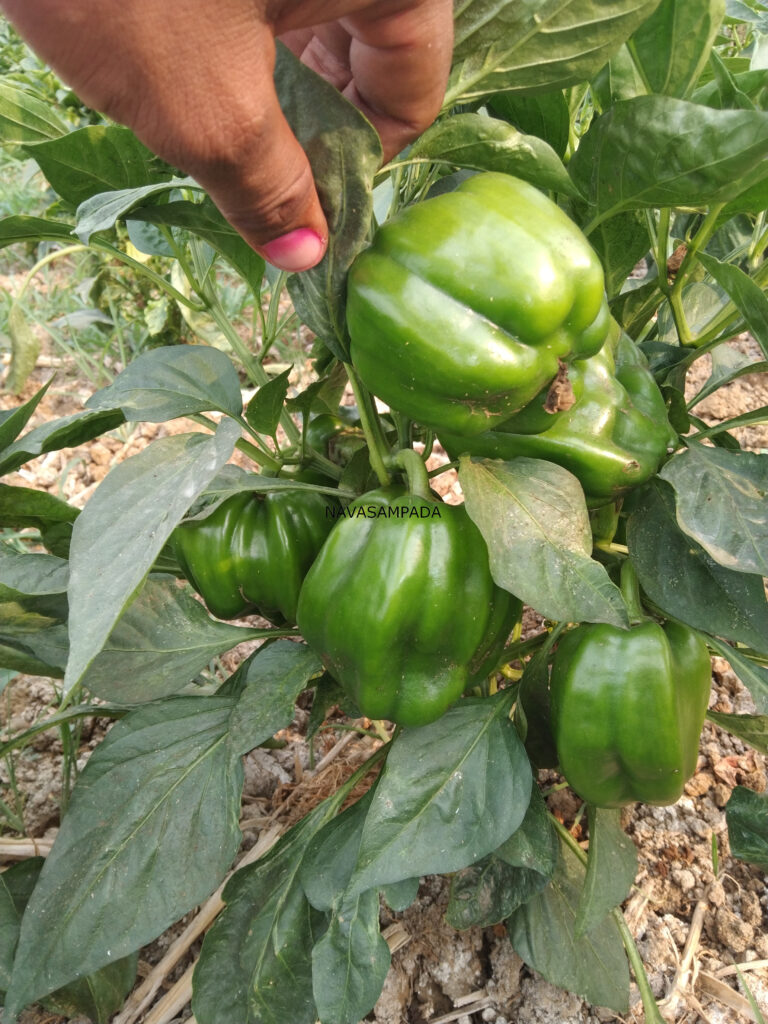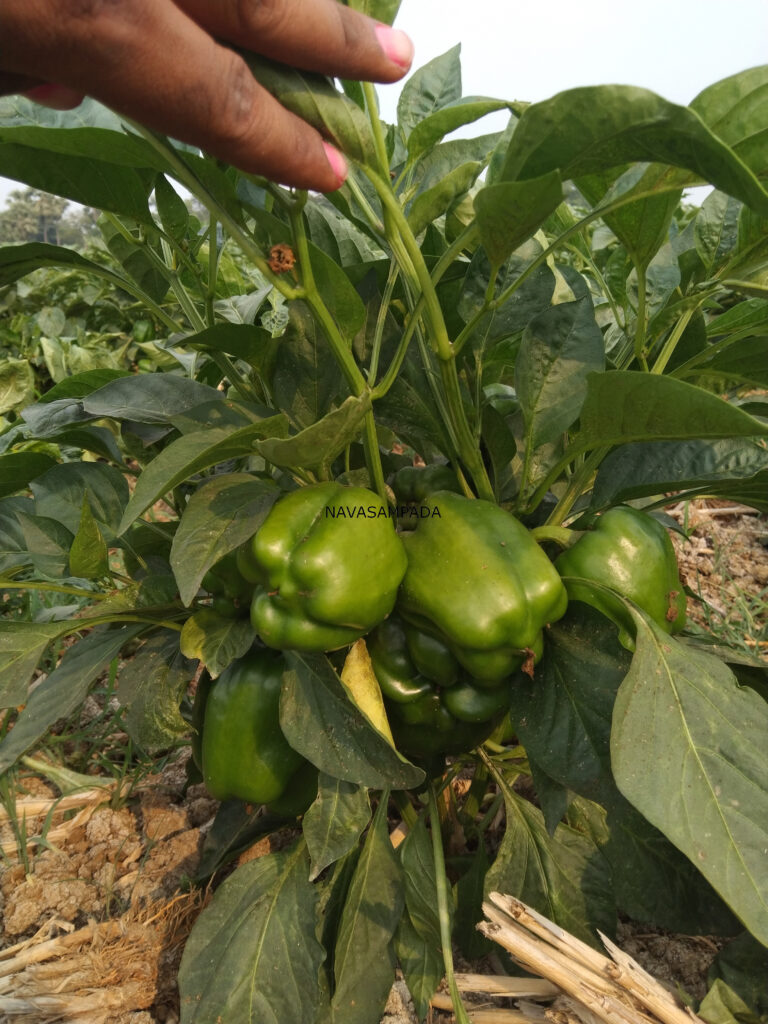Capsicum farming (also known as bell pepper or sweet pepper farming) can be a lucrative and rewarding agricultural venture when approached with care and the right practices. This guide provides an overview of the key steps to successfully grow capsicum, from land preparation to harvest and beyond.
1. Climate and Soil Requirements
Climate: Capsicum thrives in warm climates with temperatures ranging from 18°C to 30°C. It is sensitive to frost and extreme heat, so avoid planting in areas prone to cold weather or intense heat.
Soil: Loamy or sandy loam soil that is well-drained and rich in organic matter is ideal. The soil’s pH should be between 6.0 and 6.8 for optimal growth.



Sunlight: Capsicum requires at least 6-8 hours of direct sunlight daily to grow strong and produce healthy fruits.
2. Choosing the Right Variety
Select disease-resistant, high-yielding varieties suited to your climate. Popular varieties include California Wonder, Yolo Wonder, and Pusa Deepti in regions like India. Choose varieties that are in demand in your local market, such as red, yellow, or orange capsicum for their higher market value.
3. Seed Preparation and Sowing
Seed Treatment: To protect the seeds from soilborne diseases, soak them in warm water (45°C) for 30 minutes or treat them with a fungicide like Captan or Thiram.
Nursery Preparation: Prepare raised nursery beds about 1 meter wide and 20 cm high. Sow the seeds in rows 5 cm apart and lightly cover with soil. Water regularly and provide protection from heavy rain and direct sunlight.
Germination: Seeds typically take 7-14 days to germinate under optimal conditions (25-30°C). Once the seedlings have 4-5 true leaves, they are ready to be transplanted.
4. Land Preparation and Transplanting
Land Preparation: Clear the land of weeds and debris, then plow the soil 2-3 times. Enrich the soil with 10-15 tons of well-decomposed organic matter or compost before planting.
Spacing: Maintain spacing of about 60 cm between plants and 45-60 cm between rows to allow adequate air circulation and prevent overcrowding.
Transplanting: Transplant seedlings on a cloudy day or in the evening to reduce transplant shock. Water them immediately after transplanting to ensure establishment.
5. Irrigation
It requires consistent moisture, particularly during the flowering and fruiting stages. The most efficient method is drip irrigation, which ensures the roots receive a steady supply of water without wasting it. If using surface irrigation, avoid waterlogging, which can lead to root rot.
Water early in the morning or late in the afternoon to prevent fungal diseases from developing on the leaves during hot midday conditions.
6. Nutrient Management
Organic Matter: Before planting, apply 10-15 tons of organic manure (like compost or farmyard manure) to improve soil structure and fertility.
Fertilization: Apply a balanced fertilizer with a 60:40:60 kg/ha ratio of Nitrogen (N), Phosphorus (P), and Potassium (K). Split the nitrogen application into two doses at 30 and 45 days after transplanting to support healthy growth and fruiting.
Micronutrients such as calcium and magnesium can be added if necessary to improve fruit quality.
7. Weed Management
Mulching: Apply organic mulch (straw, grass) or plastic mulch to control weeds, conserve moisture, and keep the soil temperature stable.
Manual Weeding: Regularly remove weeds, particularly in the early stages of plant growth, to reduce competition for nutrients and water.
8. Plant Training and Pruning
Pruning: Prune the lower branches to improve airflow and prevent disease. Pinch off the top tips of the plant to promote branching and more fruit production.
Staking: Capsicum plants may need support, especially in windy areas. Use stakes, trellises, or cages to support the plants and prevent them from toppling over as the fruits grow heavier.
9. Pest and Disease Control
Common Pests: Aphids, whiteflies, spider mites, and thrips. Use eco-friendly treatments like neem oil or insecticidal soap to manage pest populations.
Diseases: Capsicum is susceptible to powdery mildew, bacterial wilt, and anthracnose. To manage these, maintain proper spacing, avoid overhead irrigation, and regularly inspect the plants for signs of infection.
Crop Rotation: To reduce the risk of soilborne diseases, practice crop rotation and avoid planting capsicum in the same field for consecutive seasons.
10. Harvesting
Timing: Capsicum is typically ready for harvest 60-90 days after transplanting, depending on the variety and growing conditions.
Harvesting Process: Harvest when the fruits are fully mature. Green capsicum can be harvested when firm, while red, yellow, or orange capsicum should be left on the plant until they reach their full color.
Use sharp scissors or pruning shears to cut the fruit from the plant, leaving a small part of the stem attached.
11. Post-Harvest Handling
Sorting and Grading: Sort the capsicum by size, color, and quality. Remove any damaged or diseased fruits.
Storage: Store capsicum in a cool, dry place at a temperature of 8-10°C to maintain freshness. Capsicum can last up to 2 weeks when stored properly in cool conditions.
Packaging: Pack capsicum in crates or ventilated containers to prevent bruising and ensure air circulation during transport.
12. Marketing
Market Channels: Capsicum can be sold at local markets, supermarkets, or directly to restaurants. Consider diversifying your sales channels for better profitability.
Value Addition: Explore value-added products such as pickling, drying, or making sauces to increase profitability.
Capsicum Farming: Benefits and Tips for Successful Cultivation
Capsicum, commonly known as bell pepper, is a versatile and nutrient-packed vegetable that is a favorite in kitchens worldwide. With its vibrant colors and sweet flavor, capsicum farming offers numerous benefits not only to the farmer but also to the consumers who enjoy its health advantages.
1. Rich in Vitamins and Antioxidants
It is an excellent source of vitamins, particularly vitamin C, which supports immune function, skin health, and wound healing. Red bell peppers, in particular, contain more vitamin C than oranges. Additionally, capsicum is rich in antioxidants like carotenoids (including beta-carotene), which help protect the body from oxidative stress and reduce the risk of chronic diseases.
2. Supports Immune Health
The high vitamin C content in capsicum plays a significant role in strengthening the immune system. Regular consumption of bell peppers can help the body fight off infections and illnesses. Capsicum farming provides a reliable supply of this essential vitamin, especially in colder seasons when immune support is crucial.
3. Promotes Eye Health
Capsicum, especially the red variety, is rich in carotenoids like lutein and zeaxanthin, which are important for maintaining good vision. These antioxidants help protect the eyes from damage caused by UV light and reduce the risk of age-related macular degeneration (AMD). Growing capsicum is a natural way to provide nutrients that promote eye health.
4. Aids in Weight Management
It is low in calories but high in fiber, making it an excellent choice for weight management. The fiber content helps promote satiety, reducing hunger and overeating. Capsicum farming offers a sustainable way to grow a healthy vegetable that supports a balanced, calorie-conscious diet.
5. Improves Digestion
The fiber found in capsicum contributes to a healthy digestive system by supporting regular bowel movements and preventing constipation. Growing capsicum can improve dietary fiber intake, which aids in the smooth functioning of the digestive tract.
6. Boosts Metabolism
Capsicum contains capsaicin, a compound responsible for its mildly spicy taste. Capsaicin has been shown to increase metabolic rate and promote fat burning, making it a useful addition to a diet aimed at weight loss or maintaining a healthy weight. Capsicum farming provides access to this natural metabolism booster directly from the source.
7. Versatile Culinary Use
It is incredibly versatile in the kitchen. It can be eaten raw, grilled, roasted, or sautéed, making it a staple ingredient in salads, soups, stir-fries, and more. The growing demand for fresh, flavorful bell peppers makes capsicum farming a profitable venture for farmers interested in supplying fresh produce to local markets.
8. Sustainable and Easy to Grow
It is a relatively easy crop to grow, requiring a warm climate and well-drained, fertile soil. It can be cultivated in greenhouses, raised beds, or traditional open fields. Capsicum farming can yield multiple harvests in one growing season, ensuring a continuous supply of fresh produce. This makes it a great choice for small-scale or large-scale farming operations.
Tips for Successful Capsicum Farming:
- Soil Requirements: Capsicum plants thrive in loose, well-draining soil rich in organic matter. The soil pH should ideally be between 6.0 and 6.8 for optimal growth.
- Climate Preferences: Capsicum prefers warm temperatures, between 70°F to 85°F (21°C to 29°C). It is best to plant after the last frost date when the soil has warmed.
- Watering Needs: Regular watering is essential, but be careful not to overwater. Capsicum plants should be watered deeply, ensuring the soil is moist but not waterlogged.
- Pest and Disease Control: Capsicum plants can be vulnerable to aphids, whiteflies, and fungal diseases. Use organic pesticides and practice crop rotation to keep pests at bay.
Conclusion
Capsicum farming, when done with proper care, can result in high yields and excellent profits. By following these steps—choosing the right variety, preparing the land properly, managing pests and diseases, and ensuring optimal growing conditions—you can achieve a successful harvest. With good market strategies, capsicum farming can be both a productive and profitable enterprise.